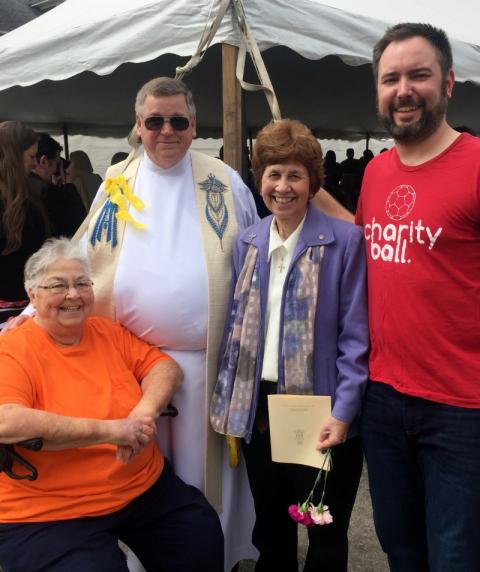
Members of the Catholic Community of Flint in Michigan present an icon of Mother, Mary of Flint at St. Mary Church, along with replicas to be placed in the three other churches of the community on Mother's Day, May 13. (Gary Pearce)
When driving into the city of Flint, the overwhelming appearance is one of despair and desolation. The rows of abandoned houses speak loudly of a city that once flourished with the promises of American industrialization and now faces the realities of poverty.
Standing over the city, framed on all sides by deserted General Motors factory lots, is the Flint Water Plant. In 2014, the plant was seen on news stations and in newspapers around the country as representative of a water crisis that affected a city deeply in need.
Flint was once the home to 12 Catholic parishes, dating back to the establishment of St. Michael in 1834 by the Irish immigrant community. That number has been halved, but a unique approach to ministry, called Faith in Flint, is banding the community together to provide hope for the future.
Fr. Tom Firestone, a priest in the Lansing Diocese, is the leader and visionary of Faith in Flint, created in 2015 in collaboration with Bishop Earl Boyea. Firestone, pastor of the four-church Catholic Community of Flint, saw a need to bring the city together, empower people of faith, and rebuild the infrastructure of Catholic outreach.
"Necessity is the mother of invention," Firestone, 66, said in regards to the beginning of this initiative. "Flint is in deep trouble."
The population has declined drastically. In 1960, according to the U.S. Census, Flint had almost 200,000 residents. But, over the decades, General Motors cut back from 80,000 jobs to some 7,000 jobs, and by 2017, the population had fallen to an estimated 96,000 residents. As residents left, the city's schools and churches closed, houses were left vacant, and jobs were unavailable. The symptoms of poverty increased, including crime, food insecurity, drug use and homelessness.

From left: St. Joseph Sr. Judy Blake, Fr. Tom Firestone, Dominican Sr. Carol Weber and Steve Wolbert (Nancy Kehoe)
As Faith in Flint developed, the initiative brought together several ministries to serve the community and create systematic change. These include the Catholic Community of Flint, St. Luke NEW Life Center, Dorothy's House of Coffee, Firestone Center and St. Francis Prayer Center. Its leadership is deeply committed to serving the community both inside and outside the church buildings.
"If we are going to be church, we are going to be church," Firestone said. "That means we are going to be church for everybody. It's a whole way to break down parochial boundaries and having people understand evangelization means to get out there and not waiting in the pews for people to show up and begin to think of church in a different way."
Dominican Sr. Carol Weber and St. Joseph Sr. Judy Blake began their work in 1996 by walking the streets and asking people about their needs. The sisters said that churches were beginning to close at that time and Catholic school buildings were vacant.
Through an effort to use the abandoned school building of St. Luke Church, they met with women in 2002 to ask what was needed in the north side neighborhood. The building, named the St. Luke NEW (North End Women's) Life Center, became a place for women to earn a GED diploma, get help in caring for children, build self-confidence and learn job skills. It has expanded to include a food pantry that serves 3,000 people a month, a job-training center for men and women, and other opportunities for education, and it will soon house a community garden and bakery.
As Weber and Blake watched the center grow, they also saw a new spirit of church develop.
"This is a whole new way of living church in Flint," Weber said. "With parishes closing and merging, it is no longer just my parish; the city of Flint is our parish. These closings forced us into recognizing the fact that we are one church, this whole experience has stretched people to realize we are a city that encompasses the homeless, the helpless, the more affluent, everybody."
Advertisement
Cara Manns, a Flint resident whose life has been affected by poverty, experienced the impact of this initiative. Manns was a regular visitor to the north side food bank, needing food and clothing for her children. She was part of the initial 2002 meeting with Weber and Blake and was one of the first graduates of the program. She got work cleaning bathrooms and eventually became the receptionist for the center.
"This center here is a lifesaver for this end of town," Manns said. "The Catholic community does not judge. The doors are always open."
Manns, who is not Catholic, said she had a lot of walls up when first visiting the food bank. "I had a motto when first coming here that if they are going to change me for the better, I am going to let them try," she remembered. "They broke those walls down and now I'm seeing myself helping people."
Dorothy's House of Coffee is located at the intersection of many neighborhoods and churches in Flint. Named after Dorothy Day, this place of hospitality is what Firestone calls a "chapel of the laity." Coffee and cinnamon rolls are available by a free-will offering. On the other side is a chapel used by local college campus ministry programs, community members who want to gather, and a group that keeps a daily schedule of prayer.

The outreach team of the Catholic Community of Flint in front of Dorothy's House of Coffee in Flint, Michigan (Kim's Photography)
Steven Wolbert, originally from Flint, was recruited by Firestone to begin an alternative spring break program and introduce others to what is happening in the city. This program, started in 2009 in Wolbert's house, brings together several groups of college students annually to learn about the ministries of Faith in Flint and meet those who are making a difference.
Now, based out of an unused church rectory, students spend a week serving on projects such as tearing down abandoned homes, helping in elementary schools and food banks, and meeting with community members.
"These programs support people with encouragement and enthusiasm who are here doing the work on a regular basis," Wolbert said. "These relationships with people and the community break down common misconceptions of what service is and what is happening in Flint."
Wolbert believes that Firestone's vision has inverted the Mass by emphasizing the community outside the church doors. "What happens at Mass has fueled the community," he said. "To be authentic to what is needed in the neighborhoods."
Wolbert has also enjoyed seeing trip participants create a more meaningful vision of church over the years and develop a relationship with God through the experience.
As Firestone talks about his own outreach, he draws heavily on the team approach that has developed. He sees this effort as building new groundwork and proactively preparing the church and laypeople for the work ahead.

A choir combined from all of the churches in the Catholic Community of Flint sings during the dedication of Flint, Michigan, to the Virgin Mary at St. Mary Church May 13. (Gary Pearce)
"I am asking some laypeople who are a part of our team to go back to school," Firestone said. "These are the people who are going to be the leaders of the church in Flint because to be perfectly honest, our presbyterate is going to be half of what it is now in 10 years."
Faith in Flint has added more partners and the city has dedicated itself to the intercession of Mary, Mother of Flint. In a ceremony held May 13 at St. Mary Church, part of the Catholic Community of Flint, an icon was presented to the community representing many different populations and ages.
"We should never take for granted that we are one Church," Firestone wrote in a blog after the celebration. "It is a struggle to be one Church, but with the prayers and intercessory power that Mary, Mother of Flint holds for us, we will continue to grow in Grace."
[Colleen Dunne is a former NCR Bertelsen intern. She currently serves as director of campus ministry at St. Mary's University of Minnesota in Winona. She traveled to Flint twice over the past year with student immersion groups to work with Faith in Flint.]







